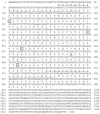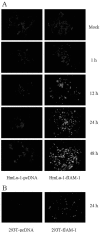Junctional adhesion molecule 1 is a functional receptor for feline calicivirus
- PMID: 16611908
- PMCID: PMC1472022
- DOI: 10.1128/JVI.80.9.4482-4490.2006
Junctional adhesion molecule 1 is a functional receptor for feline calicivirus
Abstract
The life cycle of calicivirus is not fully understood because most of the viruses cannot be propagated in tissue culture cells. We studied the mechanism of calicivirus entry into cells using feline calicivirus (FCV), a cultivable calicivirus. From the cDNA library of Crandell-Rees feline kidney (CRFK) cells, feline junctional adhesion molecule 1 (JAM-1), an immunoglobulin-like protein present in tight junctions, was identified as a cellular-binding molecule of the FCV F4 strain, a prototype strain in Japan. Feline JAM-1 expression in nonpermissive hamster lung cells led to binding and infection by F4 and all other strains tested. An anti-feline JAM-1 antibody reduced the binding of FCV to permissive CRFK cells and strongly suppressed the cytopathic effect (CPE) and FCV progeny production in infected cells. Some strains of FCV, such as F4 and F25, have the ability to replicate in Vero cells. We found that regardless of replication ability, FCV bound to Vero and 293T cells via simian and human JAM-1, respectively. In Vero cells, an anti-human JAM-1 antibody inhibited binding, CPE, and progeny production by F4 and F25. In addition, feline JAM-1 expression permitted FCV infection in 293T cells. Taken together, our results demonstrate that feline JAM-1 is a functional receptor for FCV, simian JAM-1 also functions as a receptor for some strains of FCV, and the interaction between FCV and JAM-1 molecules may be a determinant of viral tropism. This is the first report concerning a functional receptor for the viruses in the family Caliciviridae.
Figures









Similar articles
-
Identification of regions and residues in feline junctional adhesion molecule required for feline calicivirus binding and infection.J Virol. 2007 Dec;81(24):13608-21. doi: 10.1128/JVI.01509-07. Epub 2007 Oct 3. J Virol. 2007. PMID: 17913818 Free PMC article.
-
Conserved Surface Residues on the Feline Calicivirus Capsid Are Essential for Interaction with Its Receptor Feline Junctional Adhesion Molecule A (fJAM-A).J Virol. 2018 Mar 28;92(8):e00035-18. doi: 10.1128/JVI.00035-18. Print 2018 Apr 15. J Virol. 2018. PMID: 29386293 Free PMC article.
-
Survivin Overexpression Has a Negative Effect on Feline Calicivirus Infection.Viruses. 2019 Oct 30;11(11):996. doi: 10.3390/v11110996. Viruses. 2019. PMID: 31671627 Free PMC article.
-
[Progress in establishment and application of feline calicivirus reverse genetics operating system].Bing Du Xue Bao. 2015 Jan;31(1):74-9. Bing Du Xue Bao. 2015. PMID: 25997334 Review. Chinese.
-
Feline calicivirus.Vet Res. 2007 Mar-Apr;38(2):319-35. doi: 10.1051/vetres:2006056. Epub 2007 Feb 13. Vet Res. 2007. PMID: 17296159 Review.
Cited by
-
Use of cutting-edge RNA-sequencing technology to identify biomarkers and potential therapeutic targets in canine and feline cancers and other diseases.J Vet Sci. 2023 Sep;24(5):e71. doi: 10.4142/jvs.23036. J Vet Sci. 2023. PMID: 38031650 Free PMC article. Review.
-
Host cell p53 associates with the feline calicivirus major viral capsid protein VP1, the protease-polymerase NS6/7, and the double-stranded RNA playing a role in virus replication.Virology. 2020 Nov;550:78-88. doi: 10.1016/j.virol.2020.08.008. Epub 2020 Aug 27. Virology. 2020. PMID: 32890980 Free PMC article.
-
Identification of regions and residues in feline junctional adhesion molecule required for feline calicivirus binding and infection.J Virol. 2007 Dec;81(24):13608-21. doi: 10.1128/JVI.01509-07. Epub 2007 Oct 3. J Virol. 2007. PMID: 17913818 Free PMC article.
-
Proteomic analysis of membrane proteins of vero cells: exploration of potential proteins responsible for virus entry.DNA Cell Biol. 2014 Jan;33(1):20-8. doi: 10.1089/dna.2013.2193. Epub 2013 Nov 28. DNA Cell Biol. 2014. PMID: 24286161 Free PMC article.
-
Genetic characterization of feline calicivirus strains associated with varying disease manifestations during an outbreak season in Missouri (1995-1996).Virus Genes. 2014 Feb;48(1):96-110. doi: 10.1007/s11262-013-1005-0. Epub 2013 Nov 12. Virus Genes. 2014. PMID: 24217871
References
-
- Al-Molawi, N., V. A. Beardmore, M. J. Carter, G. E. N. Kass, and L. O. Roberts. 2003. Caspase-mediated cleavage of the feline calicivirus capsid protein. J. Gen. Virol. 84:1237-1244. - PubMed
-
- Barton, E. S., J. C. Forrest, J. L. Connolly, J. D. Chappell, Y. Liu, F. J. Schnell, A. Nusrat, C. A. Parkos, and T. S. Dermody. 2001. Junction adhesion molecule is a receptor for reovirus. Cell 104:441-451. - PubMed
-
- Bergelson, J. M., J. A. Cunningham, G. Droguett, E. A. Kurt-Jones, A. Krithivas, J. S. Hong, M. S. Horwitz, R. L. Crowell, and R. W. Finberg. 1997. Isolation of a common receptor for coxsackie B viruses and adenoviruses 2 and 5. Science 275:1320-1323. - PubMed
-
- Bittle, J. L., C. J. York, J. W. Newberne, and M. Martin. 1960. Serologic relationship of new feline cytopathogenic viruses. Am. J. Vet. Res. 21:546-547.
-
- Carter, M. J., I. D. Milton, J. Meanger, M. Bennett, R. M. Gaskell, and P. C. Turner. 1992. The complete nucleotide sequence of a feline calicivirus. Virology 190:443-448. - PubMed
Publication types
MeSH terms
Substances
LinkOut - more resources
Full Text Sources
Other Literature Sources
Research Materials
Miscellaneous

